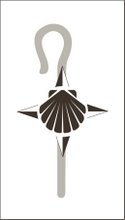May 10th, 2007
After yesterday's brief introduction to "old" and "new" Jerusalem, today's focus was on the "Old Jerusalem."
We met Henry in the morning after a restful night's sleep. We began with a walk up and down the Via Dolorosa, starting at the Lion's Gate, to the Church of the Holy Sepulcher, with many places in between. For example, we walked up an improvised bridge to the Dome of the Rock, home of Mt. Moriah, and the Al Asque Mosque. Sadly, because of most recent violence in 2001, the interior of the Dome is closed off to visitors, though the glass-tile mosaic work, along with the gold leaf Dome are exquisite to look at.
The Dome area was once home to the Temple mentioned often in the Bible, and thus it is a place of great spiritual tension and continuing religious violence.
From the Dome, we walked to Bethesda Pool and St. Anne's Chapel. St. Anne's honors not only St. Anne but Mary herself. The beauty of the Chapel is that everything is a little bit off balance and not quite in perfect symmetry. It was also saved from being destroyed during one of the times that Jerusalem was under Ottoman rule by being turned into a Muslim school.
Bethesda was far larger than I imagined. Home to the story of the one who was paralyzed and waited for the angel to stir the waters, there were numerous levels of pools by which those with disabilities would sit and wait for the stirring of waters in order to touch the waters quickly and be healed.
After stopping for a quick cup of coffee, we went along the ancient Cordo, a corridor of shops, until Henry ducked into a sweet shop. "Give the gentleman five shekels, and come with me," and with that Henry opened a door in the back of the shop, and we walked into fourth century Jerusalem! Behind the door was an arch of the Church of the Holy Sepulchre that dated back to the earliest pilgrim, Egeria, a Spanish nun of the fourth century, who not only wrote down the various liturgies used in the early church, but accurately wrote down where the Holy sites were located, maintained for years by the ancient Byzantine church prior to Helena (Constantine's mother), arrival. The sweet shop owner doesn't quite know what they will do with it all yet in terms of turning it over to the antiquity authorities.
Directly above us was the Church of the Holy Sepulchre! We entered the Church through the Ethiopian Coptics and Egyptian Copts Church chapels, which were, themselves stunning in their antiquity, with a visually stunning painting of the Queen of Sheba meeting King David.
We entered the Church of the Holy Sepulchre, and were met by pilgrims touching and praying over the large marble slab that honored the embalming of Jesus (though the embalming was to have really taken place on the Sunday after his death). To the right was the stone known simply as Golgotha! The Greek Orthodox iconography was everywhere. Touching this stone, underneath it was another stone, the cleft of Adam, where Adam was to have "originated." Walking along this level, along a corridor, we came to a tomb that was once outside the City's gates, owned by Joseph of Armithea. Near this vacant tomb was a small tabernacle, which is said to be the site of where Jesus was buried and thus rose from the dead. In order to enter and touch the stone of the place where Jesus was buried I had to wrestle with the Greek Orthodox monk who wanted to pry my hand open over a burning flame, "the light of purity." Making a sign of the cross on my open palm over the sooty debris of the candle, I prayed over the site of where Jesus was said to have been buried.
All around us were mosaics and painted icons that were stunning to the eye. Chills now and then would pass over me as I contemplated not only the possibilities of Holiness entering terra firma, but also taking in the breadth and depth of the pilgrims who have come to this place in search of the Christ.
Henry left us to tend to matters at St. Georges while we went off to Papa Andreas for lunch. The view of the Old City from the restaurant was worth the cost of the lunch! Stunning!
For the afternoon, we had some history to learn! We went to the Citadel, that was once mistakenly thought to be a part of King David's fortress. In the Citadel we watched, listened, touched, and were mesmerized by the history of this City. Many cultures and countries have laid claim to this City throughout the centuries...and more likely there will be more changing of hands.
From there we walked to the southern wall near the Western (or Wailing) wall. At the Davidson Center, we walked along the current archaeological diggings and findings of the southern part of the Old City. We saw that as each layer of dirt and grime is removed there is something new being shown about the city's former inhabitants.
That night, exhausted, we ate at a wonderful restaurant, Az Ahara, in east Jerusalem. This part of the City is Palestinian and largely Muslim, whereas west Jerusalem is largely Israeli and Jewish. The difference? We could walk right into the restaurant, and I could order a Taybeh (Palestinian) beer, while on the west Jerusalem side I would have been frisked down and there is no Taybeh beer!
Like the inner domain of the Old City, the newer parts of Jerusalem are equally divided and unique unto themselves!
Pilgrim peace, Brett
Subscribe to:
Post Comments (Atom)

No comments:
Post a Comment